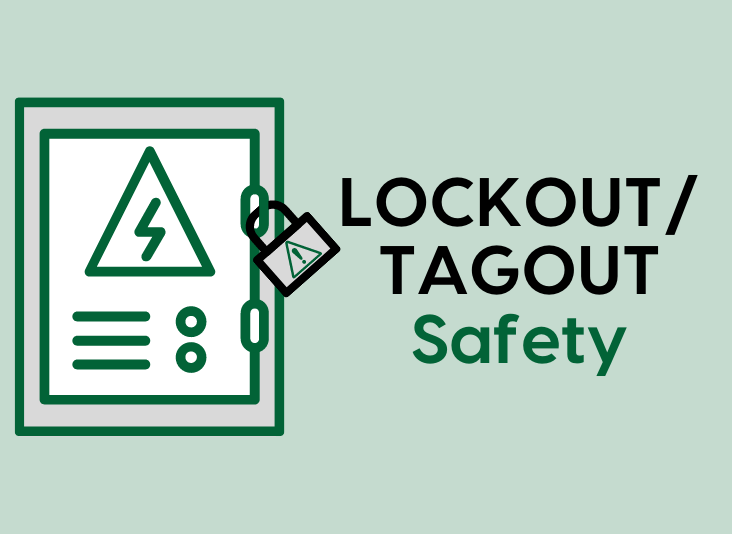4 Essentials For Your Lockout/Tagout Program
The sixth in our blog series analyzing OSHA’s top 10 most frequently cited standards discusses lockout/tagout safety requirements.
Machinery of all sorts simplifies the daily lives of workers across industries. The power that drives this key equipment, however, can be dangerous to the employees who operate and service them. Accidental activations of machines and the subsequent release of stored energy can potentially injure or even kill workers.
In 2022, the Occupational Safety and Health Administration (OSHA) reported that its Control of Hazardous Energy (Lockout/Tagout) safety standard was the sixth most violated of all of their guidelines, with 2,175 citations issued—nearly 500 more than 2021’s 1,698 violations. In both years, the ranking was the same despite a jump in infractions—underscoring an increased emphasis on this hazard.
Full understanding of all applicable safety regulations can help mitigate “lockout/tagout” (LO/TO) safety risks and better ensure employee safety. Risks of hazardous energy release are considerable, as it can cause:
- Detriment to employee health and wellbeing
- Noncompliance fines as high as $15,625 per infraction
- Damage to a company’s public image
- Operations disruptions
Facility or operations managers cannot tolerate conditions that lead to LO/TO safety noncompliance. Organizational operations, financials, reputation, and employee health are at stake.
Large Equipment Energy Hazards
Large equipment is crucial for operations across industries—and LO/TO is necessary during routine or emergency maintenance for any machines powered by electrical, mechanical, chemical, or other energy, or machines that have the potential to store energy.
This can include machines such as escalators, elevators, cranes, milling or grinding equipment, and more. The accidental startup of or release of stored energy from these machines can maim or kill workers performing maintenance. Ignorance of LO/TO standards is an invitation to unnecessary risk.
Energy sources for mechanical equipment vary—and as such, LO/TO injuries will vary as well. A steam valve can cause burns, for instance, while a shorted wire can mean electrocution. Cuts, fractures, crushing, and more can all occur as well. Managers must understand the nuances of each machine type to better understand and address all relevant safety challenges.
Proper LO/TO Procedures = Safer Work Conditions
Close adherence to all LO/TO procedures can successfully avoid dangerous hazardous energy events. At its core, LO/TO is the process maintenance workers use to safely and completely shut down large mechanical equipment when repairs need to be performed that will put technicians at risk of hazardous energy. Both lockout and tagout are invaluable processes that help further ensure worker safety when dealing with mechanical equipment.
Lockout literally means placing a lock on the machine, preventing any energy escape or activation because the machine is neutralized. Tagout, on the other hand, is placing a tag or shut-off device on a machine’s on-off switch or other shut-off control device warning workers not to start the machine.
Guidelines For Controlling Hazardous Energy
OSHA’s Control of Hazardous Energy safety standard, 29 CFR 1910.147, covers “the practices and procedures necessary to disable machinery or equipment to prevent the release of hazardous energy,” relevant when servicing or maintaining machinery in facilities of every size and type.
This standard is detailed and all-encompassing, and can be challenging to ensure you are following completely. To help ensure you remain compliant with these numerous guidelines, there are four key areas you should consider. We'll look at each area below.
One: LO/TO Training
It is an employer’s responsibility to provide LO/TO training to all workers. This training will help ensure employees understand the importance, purpose, and function of their workplace energy control program. This includes the knowledge and skills required for the safe application, usage, and removal of applicable energy controls.
Under OSHA’s LO/TO standard, there are three types of employee, each with their own training requirements:
- Authorized Employee: This category includes any person who locks or tags out machines or equipment to perform routine servicing or maintenance. Each authorized employee must receive training in:
- The recognition of applicable hazardous energy sources
- The type and magnitude of workplace energy
- Energy isolation and control methods
- Affected Employee: This is anyone who may be affected by LO/TO work, even if they aren't the ones performing the work. This includes employees whose jobs require them to operate equipment or work in an area in which LO/TO servicing is being performed. Each affected employee requires training in:
- The purpose and use of the energy control procedure
- How to remain safe in LO/TO situations
- Other Employees: This covers those whose work operations are in an area where energy control procedures may be used. While these employees may not directly interact with the equipment, they are required to be instructed on:
- LO/TO procedures
- The dangers involved with attempts to reenergize locked or tagged out equipment
- How to react safely in the case of an unexpected LO/TO complication
Additionally, all authorized and affected employees require retraining when there is a change in:
- The energy control procedure
- Their job assignments
- Machines, equipment, or processes that present a new hazard
Two: Energy Control Procedures (ECPs)
Facility managers must create and maintain ECPs for any mechanical equipment that needs service or maintenance in their facilities. This plan must clearly and specifically outline procedures for the control of hazardous energy for each machine.
This plan must include the scope, purpose, authorization, rules, and techniques needed for safe and effective handling. While there are no limitations to an energy control procedure’s design, all must:
- Identify all hazardous energy sources
- Identify specific lockout or tagout location(s) on the equipment
- Outline the type of energy isolating device(s) needed to properly lockout machines
- List employees affected by equipment shutdowns
- Outline predetermined sequences for shut-down, de-energization, energization, and start-up
Three: Periodic Inspections
At least annually, an employer must inspect all ECPs to verify adherence to the standard. Inspections should include a one-on-one between the inspector and each authorized employee, during which there will be a review of that specific employee’s responsibilities. This review must be documented, indicating the employee’s name and date of review, and stored for later compliance reporting. Only those who know the program and procedures may conduct these inspections, and they cannot be performed by those workers who rely on the ECP.
Four: Proper Supply of LO/TO Equipment
It’s the employer’s responsibility to provide whatever protective materials or hardware are most appropriate to the worksite or project—at no cost to the employees. A best practice is to create an inventory of all onsite mechanical equipment and their LO/TO protocols and requirements. Once you know what exists on site, you can quickly and easily provision the worksite with all appropriate safety devices, including:
- Locks and Tags: If an energy isolating device can be locked out, it must be locked out. If the device cannot be locked out, it must be tagged out. Some machines have multiple sources of energy—in such cases, each energy source must have a LO/TO device before maintenance can be performed.
- Lockout Devices: A lockout device, according to OSHA, is any “device that uses a … lock, either key or combination type, to hold an energy isolating device in a safe position and prevent the energizing of a machine or equipment.” Examples of lockout devices include locks, chains, blank flanges, and bolted slip blinds. These devices must be capable of withstanding the environment to which they are exposed (e.g., extreme hot or cold).
Partnering for LO/TO Success
Properly managed and routinely updated LO/TO programs are vital to protect employees in every workplace. Full review of your LO/TO program and safety proactiveness can—and will—prevent serious injury or death. Undeveloped or outdated ECPs, improper lockout devices, and inadequate training, however, can all independently mean your LO/TO program is lacking—and your employees are at risk.
Not sure where to start with LO/TO safety and compliance? Triumvirate Environmental can help. Our team of experts can assess your current program and suggest necessary changes to prevent employee injury—partnering with you throughout. Contact us today to learn more.






